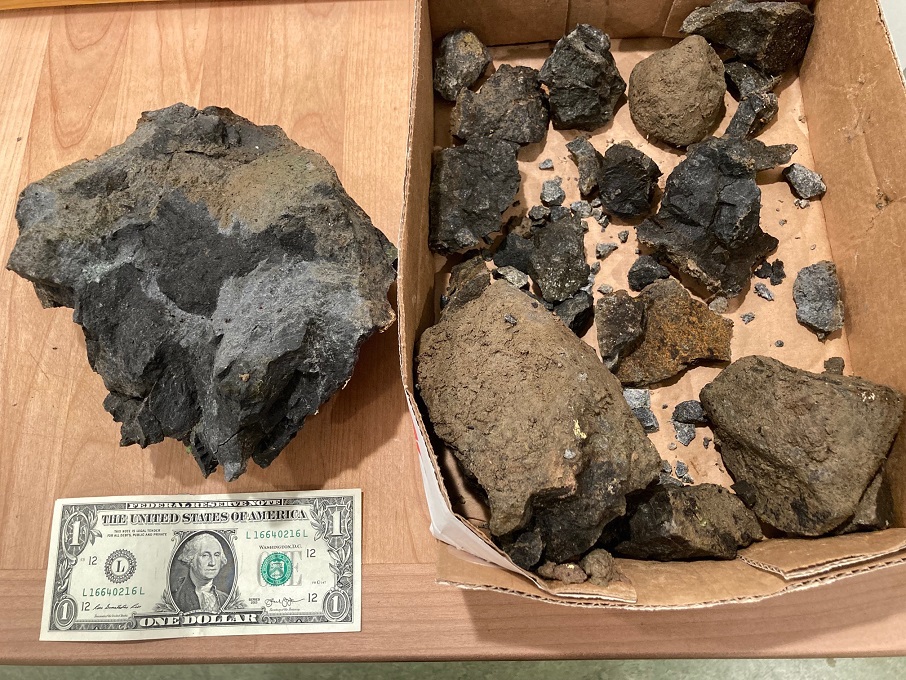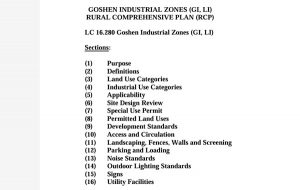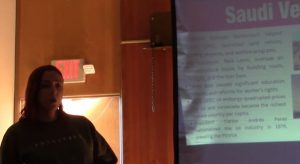EWEB identifies abandoned ‘partial’ drill hole as root cause of blasting incident
6 min read
Sandra Bishop collected some of the rocks and blast debris that struck her home Tuesday during blasting for the two new EWEB water storage tanks.
Blasting for water storage tanks in South Eugene was stopped this week, after flying rocks and debris hit a nearby home. For the EWEB East 30th Water Storage Project team, Jennifer Connors.
[00:00:14] Jennifer Connors: We started controlled underground blasting at the project site last week. On Thursday, October 28th, there was a small test blast. All of that was preplanned and pre-communicated.
[00:00:27] The test blast went completely as expected. (Tuesday Nov. 2) was supposed to be the next and regularly scheduled blast. And there was an incident that the blast did not go as expected. During the blast rocks and dirt came flying out of the blast hole and caused some cosmetic damage to an adjacent neighbor’s home, which was very unfortunate. The thing that we are all most thankful about is that no one was hurt, because the neighbor who lives in that home was outside at the time. Thankfully he wasn’t injured, no one else was injured.
[00:01:02] It’s really unfortunate because, we know that, just the term ‘controlled blasting’ is scary, right? It gets people nervous, especially if you live right in that area. And so we’ve been working really hard to build trust and set reasonable expectations about what this blasting is really going to be like. Because it’s not supposed to be like what you see in the movies, like when they, take down a building or something like that. And we understand that neighbors have been concerned, have been worried and, we felt like after the first test blast, it helped, to ‘ Oh, okay, now we see what this is going to be like and it’s not as big and scary as what TV shows.’ And then, this happened and we recognize that, we, and our team of contractors have to do some work to rebuild that trust. The best things that we can do, are be honest and transparent about what happened and then work with our team of contractors to fix it and make sure that it doesn’t happen again.
[00:02:03] And that’s what we’re doing.
Thank you for supporting
local citizen journalism
[00:02:04] John Q: Project Engineer Laura Farthing immediately shut down all work at the site.
[00:02:09] Laura Farthing: After the incident, I did immediately go to the homeowner’s house just to check, to make sure nobody was hurt. That was our main goal. And then we did a full inspection of their house. They did have some cosmetic damage. Also documented all the debris that was in the yard.
[00:02:25] And then we also stopped work at the same time, just to give us a chance, we wanted to make sure that we went through the root cause analysis so that we know exactly what happened.
[00:02:36] We do have drone footage of this blast and they were able to pretty quickly, from the drone zone in right to the portion and identify right down to the grid of holes where they put the charges, they are able to zero in on the exact hole and the exact time of the drone footage.
[00:02:56] There was an issue with the drilling and the way that the driller had drilled the holes. They got through a partial hole, and then they couldn’t continue on to the full depth that they’re supposed to go to. And they had moved to a different hole. They put the charge where it needed to be in the one that was longer. They didn’t see the one that was shorter. And then that got covered up, and so when they went to go place their mats and set charges, it looks like they missed that hole because it wasn’t visible, so it created a space basically for the energy to go. And that charge’s path of least resistance was up through that hole, whereas the rest of the blast was contained under the mat.
[00:03:34] So that’s what it looks like. like I said, it’s preliminary. They’re still finalizing their report and we’ll share the results and the mitigation strategies in a communication to neighbors, and how we’re going to get back on schedule.
[00:03:47] I haven’t seen the final plan, but that is, it sounds like that’s going to be the using a big flag to identify there’s an anomaly on the holes. They get a couple of feet of dirt over the top of it as well. So they have big flags so that it stays.
[00:04:00] And then we are correlating that to, there was a different sensation that the neighbors felt with this blast than what the first one. So we do get phone calls from some people who felt a stronger vibration, however, the vibration limits were also, were actually lower than they were for the first blast, but they were different because it became airborne rather than being contained underground. So the way that you feel that will be different. So we are looking at comparing the two blasts. There’s a consultant, a company that does the vibration monitoring and looks at all the data. He has a PhD in this. So we have him going through and looking at the different blasts and identifying what may have caused people to have a different experience this time.
[00:04:41] John Q: Although blasting is stopped, Laura said some work at the site can continue.
[00:04:45] Laura Farthing: We did meet with the contractor just to clearly lay out what we expect before we will let work start again. So we have stopped all blasting activities this week. We are allowing drilling to occur on a portion of the site. But that area is not getting blasted. We just have to drill ahead of rock excavation, and so that work is continuing. We also allowed the contractor to continue work on their erosion control measures.
[00:05:09] And then as soon as we have the final root cause analysis and we have verified that also identifies further steps they’re taking with their staff and some changes to their procedure to make sure this doesn’t happen again, other things that will include is having additional blasting mats that extend out further from the blast zone to keep it safe.
[00:05:29] Once we have verified all of those have been done, their training is done, and we have a plan in place with a schedule to repair the cosmetic damage, we’ll let work, start again on the blasting, which we anticipate will be next Tuesday.
[00:05:43] Jennifer Connors: The good news, I guess I could say if there is any good news in something like this, is that there’s nothing that points to anything being wrong with the design of the blast or the materials used or the equipment used. It was an unfortunate oversight on, one of the drill operators’ parts that he didn’t adequately mark, visibly mark, that there was a partial hole there.
[00:06:04] So you know, that’s something that needs to be corrected through the contractor with, talking to the drill operators and retraining and emphasizing their protocols. And we feel confident that they’re doing that.
[00:06:16] Even though this is work that’s being done by professional subcontractor, EWEB is still ultimately responsible for the project, and we know that neighbors look to us for explanations and they look to us to make sure that the work is being done in the safest and most efficient, possible ways. So we take it very seriously. As Laura said, we won’t approve work to resume until we’re satisfied that all of these remediations are in place.






